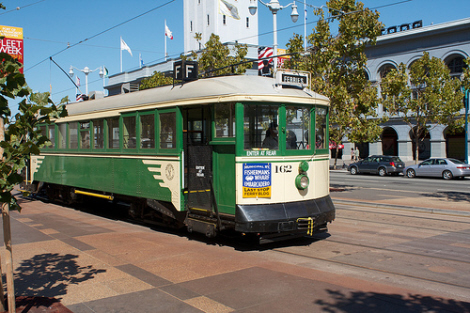Thinking about doing some renovations around the house to make it more energy efficient? Increase insulation levels? Put in more efficient windows? Maybe even install a white roof?
All of these things will help… but if you live in a car-oriented suburb, it turns out there may be one action you can take that will produce more bang for the buck than all of these options… and that’s moving.
OK, that’s probably a bit of a stretch, but Kaid Benfield at the NRDC’s Switchboard blog highlighted a new report from Jonathan Rose Companies and the EPA that shows, in terms of total energy use, a transit-oriented home, or one “…within a quarter to a half a mile of a transit stop,” likely produces the greatest energy savings for a home… more than lots of green features in a home in a car-focused development.
The report, Location Efficiency and Housing Type – Boiling it Down to BTUs, looked at total energy consumption: not just electricity and gas used in the home itself, but also transportation energy. Specifically, it examined the average total of BTUs (British Thermal Units) consumed in various housing types located in different kinds of development settings. While housing type itself made a difference in energy consumption (so, multifamily homes used less energy than detached single family homes), the report claims that “A home’s location relative to transportation choices has a large impact on energy consumption.”
How large? Well, transit orientation made the single biggest difference for a detached single-family home: in a conventional suburban development, a home consumes an annual average of 240 million BTUs per year. That same home in a transit-oriented location consumes 147 million BTUs a year… which is slightly less that a suburban home with “green” home elements and cars. The following chart provides an overview of the white paper’s findings:
Obviously, these findings have more relevance for urban planners and policy makers… you’re probably not going to jack up your house and move it (and that probably wouldn’t be cost efficient, anyway). But they also give the home buyer something to consider when s/he is shopping for housing… in addition to energy efficiency features (which are still really important).
As one commenter noted at Switchboard, this may also underscore the need to address “built-in incentives that favor sprawl” with “…performance-based parking pricing, mileage- and congestion-based roadway prices, and the transformation of the traditional property tax into a value-capture user fee.” Or, you could just raise the gas tax, and/or put a price on carbon.
See holes in the conclusions here? Got other ideas for making this kind of information more transparent to the market? Share your thoughts…
Looking for ways to cut the energy bills without moving? Check out our selection of energy efficient appliances, including refrigerators, dishwashers, air conditioners, and vacuum cleaners.
Image Credits: jay galvin at Flickr under a Creative Commons license; Jonathan Rose Companies with support from the EPA




Becky
THANK YOU! One of the reasons we bought our house was that it was walkable to a train station, and I’m glad to see that someone actually ran the numbers. Yay for transit!
KayDay
I love that I live in a walkable, close to mass transit spot. It’s super convenient and makes my life easier, and it’s great to know that even though our rental house may be a bit drafty, we are still saving energy. However, eventually the day will probably come when I want to do grown-up things like buy and house and have a child, and it’s very unfortunate that I will likely not be able to afford to continue to live in the same location. In DC, the price of real estate (even in the ‘burbs) goes up considerably the closer one is to the metro. I could not afford to buy near a metro station, regardless of my desire to go green. Yes, more incentives are needed to keep people out of the sprawl, but these should focus on making living in a walkable/mass-transit area more affordable to us not-so-rich people.
Uncle B
Corporatists/Capitalists have stolen the EV-1 electric car and its fantastic batteries from American citizens: Google, torrent, the movie “Who Stole The Electric Car”. Study this documentary carefully. Realize, not only have corporatists stolen electric cars, they have stolen space age super-insulation, miraculous denatured uranium batteries, Uber-light weight materials for car construction, replacement materials for cheaper highly insulated home construction, nuclear/electric bullet trains for the public, domestic methane production from sewage, sewage/methane powered buses, as in Norway, Sweden, zero maintenance zero energy cost home designs, by civil code bull Shiite laws to protect construction companies lumber companies, high efficiency turbo diesel/electric hybrid cars by absurd pollution standards, and a myriad of other items that simply threatened their investments, didn’t suit their agendas.
Imagine the America we would have, without these strong corporate influences, and American democracy, not and American corpocracy.
American corporatists have done one more evil, intentional or unintentional thing: they have crippled the American Nuclear Industry, they have retained old, patented, royalty collecting designs over and above the superior designs coming, now, from China. Tsinghua University, China, has, up and running, a better, pebble bed, gas reactor/ China has invested billions of Yuan in researching Thorium fueled reactors, safer, cheaper to operate reactors. Few Americans realize it but Uranium ores are all bought and purchased and sold through a Cartel, or Monopoly like process design to keep the price very high. Thorium, on the other hand, is so plentiful as to prevent this sort of situation. imagine, a safely nuclear powered America!Yes, outside the ‘tea-kettle’ American designs from the 1950’s it is so possible, and will soon be achieved by the communists in China. America needs to free up its current resources to move ahead, to move to green. America needs to clean up its act.